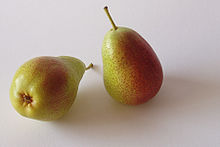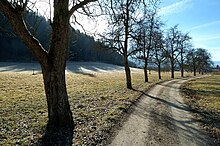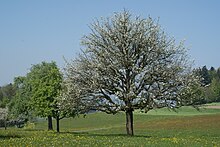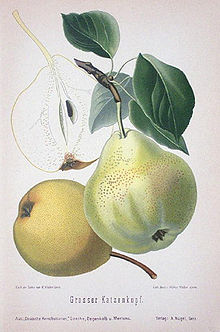Culture pear
This article has been registered in the quality assurance biology for improvement due to formal or content-related deficiencies . This is done in order to bring the quality of the biology articles to an acceptable level. Please help improve this article! Articles that are not significantly improved can be deleted if necessary.
Read the more detailed information in the minimum requirements for biology articles .
| Culture pear | ||||||||||||
|---|---|---|---|---|---|---|---|---|---|---|---|---|

Cultivated pears ( Pyrus communis ), illustration |
||||||||||||
| Systematics | ||||||||||||
|
||||||||||||
| Scientific name | ||||||||||||
| Pyrus communis | ||||||||||||
| L. |
The common Pear ( Pyrus communis L. ), also called Birnbaum , is a plant belonging to the pome fruit crops (Pyrinae) from the family of the rose family belongs (Rosaceae). It is an old cultivated plant and is cultivated in numerous varieties as a fruit tree . Their fruit is called a pear .
features
The deciduous tree shows very different growth forms depending on the rootstock, variety and cut and reaches heights of between 3 and 20 meters. Classic pear trees have steep, egg to pear-shaped crowns with pronounced trunk extensions. The bark is dark gray-brown and tears open in large scales or fields. The bark of the branches is initially shiny brown and later gray-brown. They can be thorny or thorny, depending on the variety.
Grafted pear trees live on average around 70 years old, but cider pear trees sometimes also live for 200 years. Pear locations should have deep, nutrient-rich soils with a good water supply free of waterlogging and a rather dry and warm climate.
leaves
The egg-shaped to elliptical leaves are between 5 and 8 inches long and 4.5 to 5.5 inches wide. They are arranged alternately and usually stalked between 4 and 8 centimeters long. The leaf margin is finely serrated or notched, with the lower half of the leaf often entire. The leathery leaves are initially hairy and later become glabrous. Their color is glossy dark green. In autumn they take on a yellow to orange-red color.
Flower and fruit
The pungent smelling flowers are clustered together in umbellate inflorescences . The hermaphrodite, radial symmetry , five-fold flowers have a diameter of 2 to 3 centimeters. The five white petals are about 2 to 5 inches long. The anthers are mostly red. Flowering time is April and May depending on the variety. The flowers are pollinated by insects and are rarely self-fertile . The fruits are ripe for picking between July and October. The edible apple fruit , with its typical pear shape , is between 5 and 16 centimeters long and 4 to 12 centimeters wide. They are juicy and sweet. A distinction is made between the pear types with regard to the best possible use of their fruits in table, cooked or must types.

bark
The light to black-gray bark forms a so-called cube bark, as it has sharp transverse and longitudinal cracks and divides it into cube-shaped fields. This texture makes the pear tree easily recognizable even in winter.
Chromosome number
The number of chromosomes is 2n = 34, 51 or 68.
ecology
The cultivated pear is a deciduous tree with no winter. The autumn brown color of their leaves is caused by the oxidation of hydroquinone to quinone . The species forms a deep tap root with VA mycorrhiza .
The flowers are female nectar - bearing disc flowers. When the flowers open, the scars are ready to conceive. The flowers have an unpleasant odor of trimethylamine , similar to herring brine. The scar tissue smells different and stronger than the petals. The flowers are self-sterile. Pollinators are honey bees , which collect pollen in particular , beetles , two-winged birds , etc. The flowering time is April and May depending on the variety.
The fruits are apple fruits; its pulp has grain-like groups of stone cells. Digestion and storage spread through birds , mammals and humans. In some cultivars, fruits develop without ripening seeds ; this is called virginity or parthenocarpy .
Vegetative propagation occurs through root shoots.
In our latitudes, cultivated pears are usually grafted onto quince supports, Cydonia oblonga , for refinement , whereby the quince transmits certain properties, such as: B. a more intense aroma of the fruit.
Ingredients of the fruits
| Nutritional value per 100 g of pear | |
|---|---|
| Calorific value | 219–233 kJ (52–55 kcal) |
| protein | 0.38 g |
| carbohydrates | 15.46 g |
| - of which sugar | 9.80 g |
| - fiber | 3.1 g |
| fat | 0.3 g |
| Vitamins and minerals | |
| Vitamin B 1 | 0.012 mg |
| Vitamin B 2 | 0.025 mg |
| Vitamin B 3 | 0.157 mg |
| Vitamin B 5 | 0.048 mg |
| Vitamin B 6 | 0.028 mg |
| Vitamin B 9 | 7 µg |
| vitamin C | 4.2 mg |
| Calcium | 9 mg |
| iron | 0.17 mg |
| magnesium | 7 mg |
| phosphorus | 11 mg |
| potassium | 119 mg |
| zinc | 0.10 mg |
Pears consist of 83% water and contain around 10% carbohydrates (including pectins ), 3% fiber , protein, fat, minerals , vitamins and fruit acids .
| Daily requirement of an adult | |||
| potassium | Calcium | magnesium | vitamin C |
| 6% | 1 % | 2% | 7% |
Source: EU Nutrition Labeling Directive (EU NWKRL 90/496 / EEC)
history
The cultivated pear is an old, hybridogenic cultivated plant that originated from several wild species common in Europe and West Asia, probably mainly from Pyrus syriaca (South West Asia), Pyrus pyraster (Central Europe) and Pyrus nivalis (South Mediterranean). Originally it was cultivated for the first time in the Middle East and reached Central Europe early, where it is documented for the Neolithic in the area around Lake Constance. In Greece it has been used since around 1000 BC. Cultivated, the Romans took over the culture. After the end of the Roman era, the cultivation declined, but it was increasingly cultivated again from 600 AD by monasteries and aristocrats. From around 1750 a golden century began for the cultivated pear and numerous new varieties were created.
The first publication of Pyrus communis by Carl von Linné in 1753 in Species Plantarum , 479.
Varieties (selection)
- ' Alexander Lucas '
- ' Conference '
- ' Trout Pear '
- ' Early from Trévoux '
- ' Gellert's Butter Pear '
- ' Great French Cat 's Head '
- ' Good Luise '
- 'Dr. Jules Guyot ', named after Jules Guyot
- ' Karcher Pear '
- Knauspirne
- ' Delicious from Charneux '
- Mollebusch
- ' Most pear '
- ' Packhams '
- ' Palmisch Pear '
- ' Swiss water pear '
- ' Williams Christ '
See also list of pear varieties .

Dwarf fruit
Nowadays, pears are also very popular as fruit dwarfs , in which normal table types are refined on a poorly growing base, so that the final height of the tree is below 1.50 m, but a harvest of several kilograms per year is still possible.
Diseases and pests
- Pear grid ( Gymnosporangium sabinae ), a rust fungus
- Pear leaf suckers ( Cacopsylla pyri ), a leaf flea (Sternorrhyncha: Psyllidae)
- Pear bud prick ( Anthonomus piri )
- Pear decay (triggered by phytoplasms )
- Fire blight
- Pearpox mite ( Eriophyes pyri )
- Black spot disease
- Pear scab ( Venturia pyrina )
use
The climacteric fruits can only be stored for a limited time and therefore primarily provide fresh fruits . They are also processed into dried fruit ( Kletzen ), syrup ( pear herb ), jam, juice and alcoholic drinks ( fruit brandies ) or canned. The wood is used as durable and valuable joiner's wood and in musical instrument making.
Due to the comparatively low production of sugar ( glucose : 0.05-0.30 mg / day / Bloom at 5-48% sugar content in the nectar) the bulb in Europe imkerlich despite their frequency no authoritative head garb .
See also
- Bollweiler pear (crossbreed)
swell
literature
- Mark Bachofer & Joachim Mayer: The new cosmos tree guide . Stuttgart 2006, ISBN 3-440-10217-3 .
- Manfred A. Fischer , Wolfgang Adler, Karl Oswald: Excursion flora for Austria, Liechtenstein and South Tyrol. 2nd, improved and enlarged edition. State of Upper Austria, Biology Center of the Upper Austrian State Museums, Linz 2005, ISBN 3-85474-140-5 .
- Erich Oberdorfer : Plant-sociological excursion flora . 8th edition, Ulmer, Stuttgart 2001, ISBN 3-8001-3131-5 .
- Ruprecht Düll , Herfried Kutzelnigg : Pocket dictionary of plants in Germany and neighboring countries. The most common Central European species in portrait. 7th, corrected and enlarged edition. Quelle & Meyer, Wiebelsheim 2011, ISBN 978-3-494-01424-1 .
Individual evidence
- ↑ Karl-Heinz Varnicek: fruit growing in the garden . 10th edition, VEB Deutscher Landwirtschaftsverlag, Berlin 1981, p. 33 f.
- ↑ Horst Köhler: The practical garden book . 38th edition, C. Bertelsmann, Gütersloh 1961, p. 357 f.
- ^ Erich Oberdorfer : Plant-sociological excursion flora for Germany and neighboring areas . With the collaboration of Angelika Schwabe and Theo Müller. 8th, heavily revised and expanded edition. Eugen Ulmer, Stuttgart (Hohenheim) 2001, ISBN 3-8001-3131-5 , pp. 502 .
- ↑ Archived copy ( memento of the original from March 3, 2015 in the Internet Archive ) Info: The archive link was inserted automatically and has not yet been checked. Please check the original and archive link according to the instructions and then remove this notice.
- ↑ a b c Klaus Becker, Stefan John: Color atlas useful plants in Central Europe . Verlag Eugen Ulmer, Stuttgart, 2000, ISBN 3-8001-4134-5
- ↑ Erich Oberdorfer : Plant-sociological excursion flora . 8th edition, Ulmer, Stuttgart 2001, ISBN 3-8001-3131-5 .
- ↑ Helmut Horn, Cord Lüllmann: Das große Honigbuch , Kosmos, Stuttgart 3rd edition 2006, p. 29f. ISBN 3-440-10838-4 .




